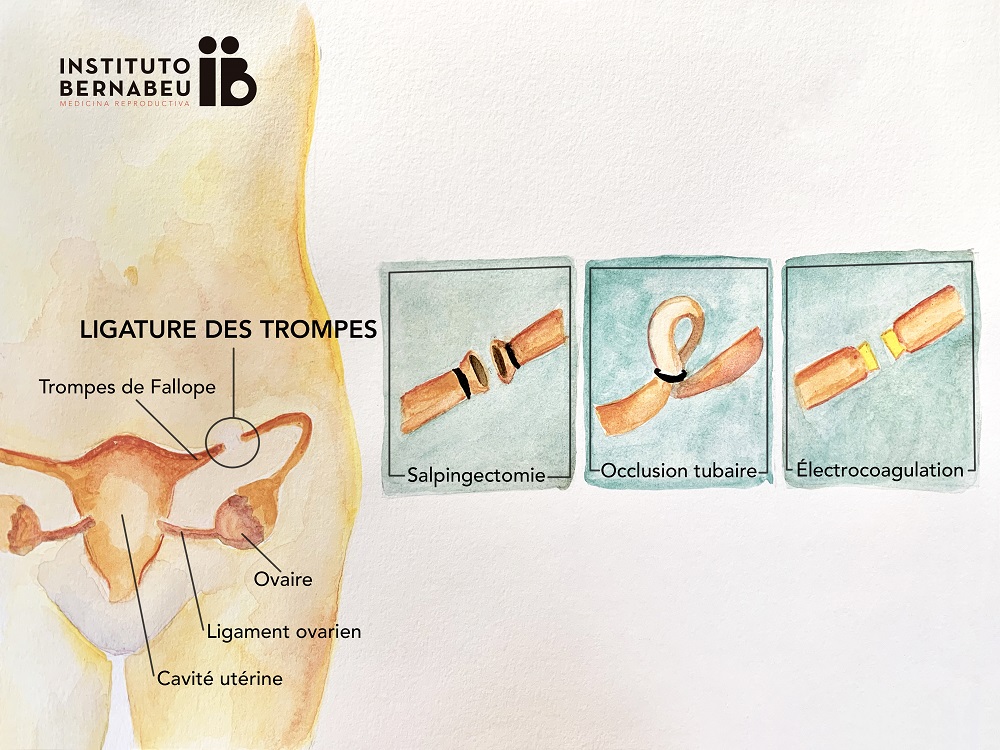Tubal ligation is a permanent method of contraception for women. It offers advantages such as freedom from forgetfulness and long-term effectiveness. However, it also has disadvantages, such as the irreversibility of the procedure and possible side effects. So it's important to weigh up the pros and cons before making a decision.
Tubal ligation: behind the scenes of this permanent contraception - Le Magazine de la Santé
[arve url="https://www.youtube.com/embed/VT5xzzdUwgI "/]
What are the side effects of tubal ligation?
Tubal ligation, also known as tubal sterilization, is a surgical procedure used to prevent fertilization in women. However, as with any medical procedure, there are potential side effects and risks.
Common side effects of tubal ligation include:
- Abdominal pain: It is normal to feel some pain after surgery. This may last from a few days to a few weeks.
- Back or shoulder pain: this may be caused by the gas used during surgery to inflate the abdomen.
- Bleeding: slight bleeding may occur after tubal ligation.
- Infection: although rare, there is a small risk of infection after surgery.
- Allergic reactions: some women may react to anesthetics or drugs used during the operation.
There are also more serious risks associated with tubal ligation, although these are rare:
- Ectopic pregnancy: there is a slightly increased risk of ectopic pregnancy (outside the uterus) after tubal ligation.
- Regret: some women may regret their decision to have a tubal ligation, especially if their personal circumstances change, such as a new partner or the desire to have more children.
It is important to note that tubal ligation is considered a permanent method of contraception and may be difficult, if not impossible, to reverse. It is essential to make an informed decision and discuss all options with a healthcare professional before proceeding with this procedure.
It is advisable to consult a physician for detailed and accurate information on the potential side effects of tubal ligation, as well as on contraceptive alternatives.
How are my periods after a tubal ligation?
After tubal ligation, there are several rules to follow to ensure optimal recovery. It's important to note that these rules may vary from person to person, and should be discussed with a healthcare professional.
1. Rest and recovery : After the procedure, we recommend resting for a few days. Avoid strenuous physical activity and give your body time to heal.
2. Pain and discomfort : Abdominal pain or cramping is normal after tubal ligation. You can take painkillers recommended by your doctor to relieve these symptoms.
3. Medical follow-up : Be sure to make an appointment for post-operative medical follow-up. Your doctor will assess your overall health and make sure everything is going well.
4. Sexual activity : After the procedure, it is generally recommended to avoid sexual intercourse for a set period to allow your body to heal properly. Discuss this with your doctor for specific guidelines.
5. Contraception : Although tubal ligation is considered a permanent contraceptive method, it is important to understand that it does not offer 100 % protection. If you have any concerns about contraception, talk to your doctor to discuss other available options.
6. Side effects : Be aware of possible side effects such as abnormal bleeding, persistent pain or other worrying symptoms. If you notice anything unusual, contact your doctor immediately.
Remember, everyone reacts differently to tubal ligation, so it's important to follow your doctor's advice and ask all your questions and concerns.
Does tubal ligation hurt?
Tubal ligation, also known as tubal sterilization, is a surgical procedure performed on women to render them infertile. The pain experienced during this procedure varies from person to person.
Most women experience some pain or discomfort after tubal ligation. However, this pain is usually mild to moderate and can be alleviated by painkillers prescribed by the doctor.
It's important to note that tubal ligation is a surgical procedure and there may be associated risks, such as infection, excessive bleeding or complications from anesthesia. It is therefore essential to discuss these risks with your doctor before making any decisions.
In conclusion, although tubal ligation can cause some pain or discomfort, it is usually manageable with painkillers. It's important to talk to your doctor for precise information about the procedure and the possible risks involved.
What are the disadvantages of female sterilization?
Female sterilization is a permanent method of contraception with certain drawbacks. First and foremostHowever, this surgical procedure requires general anesthesia, which always entails a health risk for the woman. In addition, female sterilization is irreversibleThis means that the woman cannot have children in the future, even if she changes her mind.
In additionHowever, sterilization can lead to post-operative complications such as infection, excessive bleeding or chronic pain. It is also possible for the procedure to fail and for the woman to remain fertile, although this is rare.
In additionHowever, it is important to note that female sterilization does not protect against sexually transmitted infections (STIs). It is therefore necessary to use other methods of protection, such as condoms, to prevent these infections.
Finally, the decision to undergo sterilization is often final and can have significant psychological consequences. Some women may feel sad or regretful after the operation, especially if they made the decision at a young age.
Despite these drawbacks, it should be stressed that female sterilization may be an appropriate option for some women who do not wish to have children in the future. However, it's important to think carefully about this decision and discuss all available contraception options with a healthcare professional.
In conclusion, tubal ligation has both advantages and disadvantages that need to be seriously considered. On the one hand, this permanent procedure offers an effective method of contraception for women who have already decided not to have any more children and wish to avoid any unwanted pregnancies. Tubal ligation is a reliable and definitive option, allowing women to feel in control of their fertility.
On the other hand, it's important to consider the negative aspects of this procedure. As with any surgical procedure, tubal ligation carries risks, albeit rare ones, such as infection, complications during anesthesia or excessive bleeding. What's more, it's important to stress that tubal ligation is a permanent and irreversible decision. It is therefore essential to be certain of your choice and to consider other temporary methods of contraception before opting for this procedure.
In conclusion, before making a decision regarding tubal ligation, it is essential to thoroughly discuss the advantages and disadvantages of this option with your doctor.. Every woman has different contraceptive needs and concerns, so it's important to choose the method that best suits her personal situation. Tubal ligation may be an appropriate option for some women, but it's not for everyone. The best approach is always to make an informed decision after evaluating all available options.








